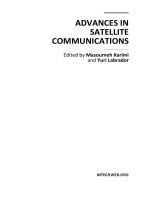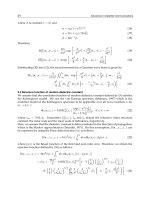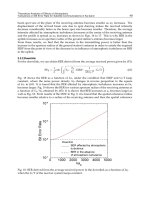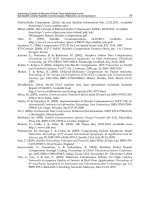Advances in Satellite Communications Part 1 pptx
Bạn đang xem bản rút gọn của tài liệu. Xem và tải ngay bản đầy đủ của tài liệu tại đây (418.23 KB, 15 trang )
ADVANCES IN
SATELLITE
COMMUNICATIONS
Edited by Masoumeh Karimi
and Yuri Labrador
Advances in Satellite Communications
Edited by Masoumeh Karimi and Yuri Labrador
Published by InTech
Janeza Trdine 9, 51000 Rijeka, Croatia
Copyright © 2011 InTech
All chapters are Open Access articles distributed under the Creative Commons
Non Commercial Share Alike Attribution 3.0 license, which permits to copy,
distribute, transmit, and adapt the work in any medium, so long as the original
work is properly cited. After this work has been published by InTech, authors
have the right to republish it, in whole or part, in any publication of which they
are the author, and to make other personal use of the work. Any republication,
referencing or personal use of the work must explicitly identify the original source.
Statements and opinions expressed in the chapters are these of the individual contributors
and not necessarily those of the editors or publisher. No responsibility is accepted
for the accuracy of information contained in the published articles. The publisher
assumes no responsibility for any damage or injury to persons or property arising out
of the use of any materials, instructions, methods or ideas contained in the book.
Publishing Process Manager Mia Devic
Technical Editor Teodora Smiljanic
Cover Designer Jan Hyrat
Image Copyright Chaikovskiy Igor, 2010. Used under license from Shutterstock.com
First published July, 2011
Printed in Croatia
A free online edition of this book is available at www.intechopen.com
Additional hard copies can be obtained from
Advances in Satellite Communications, Edited by Masoumeh Karimi and Yuri Labrador
p. cm.
ISBN 978-953-307-562-4
free online editions of InTech
Books and Journals can be found at
www.intechopen.com
Contents
Preface IX
Part 1 Antennas in Satellite Communications 1
Chapter 1 Helical Antennas in Satellite Radio Channel 3
Maja Škiljo and Zoran Blažević
Part 2 Atmospheric Effects in Satellite Links over Ka Band 27
Chapter 2 Theoretical Analysis of Effects of
Atmospheric Turbulence on Bit Error Rate
for Satellite Communications in Ka-band 29
Tatsuyuki Hanada, Kiyotaka Fujisaki and Mitsuo Tateiba
Part 3 Real Time Applications over Satellite 53
Chapter 3 Improving Quality-of-Service of Real-Time
Applications over Bandwidth Limited Satellite
Communication Networks via Compression 55
LingSun Tan, SeiPing Lau and ChongEng Tan
Part 4 Hybrid Satellite-Terrestrial Networks 81
Chapter 4 Multicast Security and Reliable Transport
of Rekey Messages over Hybrid
Satellite/Terrestrial Networks 83
Franco Tommasi, Elena Scialpi and Antonio De Rubertis
Part 5 Sensor Networks 109
Chapter 5 Design Issues of an Operational Fire Detection
System integrated with Observation Sensors 111
George Halikias, George Leventakis,
Charalambos Kontoes, Vasilis Tsoulkas,
Leonidas Dritsas and Athanasios Pantelous
VI Contents
Part 6 High Capacity Satellite Communications 133
Chapter 6 Passive Microwave Feed Chains for High
Capacity Satellite Communications Systems 135
Giuseppe Addamo, Oscar Antonio Peverini,
Giuseppe Virone and Riccardo Tascone
Part 7 Adaptive Antenna Arrays 165
Chapter 7 New Antenna Array Architectures
for Satellite Communications 167
Miguel A. Salas Natera, Andrés García-Aguilar,
Jonathan Mora-Cuevas, José-Manuel Fernández González,
Pablo Padilla de la Torre, Javier García-Gasco Trujillo,
Ramón Martínez Rodríguez-Osorio, Manuel Sierra Pérez,
Leandro de Haro Ariet and Manuel Sierra Castañer
Preface
The use of satellites in communications systems is very much a fact of everyday life, as
is evidenced by the many homes equipped with antennas, or dishes used for reception
of satellite television. What may not be so well known is that satellites form an
essential part of telecommunication systems worldwide, carrying large amounts of
data and telephone traffic in addition to the television signals.
Satellite communication systems are now a major part of most telecommunications
networks as well as our everyday lives through mobile personal communication
systems and broadcast television. A sound understanding of such systems is therefore
important for a wide range of system designers, engineers and users.
Satellites offer a number of features not readily available with other means of
communications. Because very large areas of the earth are visible from a satellite, the
satellite can form the star point of communications network, simultaneously linking
many who may be widely separated geographically. The same features enable
satellites to provide communication links to remote communities in sparsely
populated areas that are difficult to access by other means. Of course, satellites' signals
ignore political boundaries as well as geographic ones, which may or may not be a
desirable feature.
A satellite communications system uses a variety of technologies combining many
areas of engineering fields, from video compression to access techniques, modulation
schemes, and error correction capabilities. In addition, a satellite link engineer has to
consider the constrains of the communication channel; so many radio frequency
calculations are needed, these include link budget analysis, propagation effects,
amplifiers' operational points, antennas size, transmission lines, impedance matching,
etc.
This book provides a comprehensive review of some applications that have driven this
growth. It analyzes various aspects of Satellite Communications from Antenna design,
Real Time applications, Quality of Service (QoS), Atmospheric effects, Hybrid Satellite-
Terrestrial Networks, Sensor Networks and High Capacity Satellite Links.
It is the desire of the editors that the topics selected for this book can give the reader an
overview of the current trends in Satellite Systems, and also an in depth analysis of the
X Preface
technical aspects of each one of them. The editors would like to acknowledge the
support of all of those people at the InTech (Open Access Publisher) who have helped
during the process of this book. In particular, special thanks to Ms. Mia Devic for her
valuable comments, hard work and continued guidance.
Dr Masoumeh Karimi
Technological University of America,
USA
Dr Yuri Labrador
The MITRE Corporation,
USA
Part 1
Antennas in Satellite Communications
1
Helical Antennas in Satellite Radio Channel
Maja Škiljo and Zoran Blažević
University of Split, Faculty of electrical engineering,
mechanical engineering and naval architecture,
Croatia
1. Introduction
Monofilar and multifilar helical antennas are the most widely proposed antennas in satellite
communications systems. The main reason why these antennas constitute an asset in
applications concerning satellite and space communications generally is circular
polarization. Good axial ratio provides precise measurement of the polarization of the
received signal due to immunity of the circularly polarized wave to Faraday rotation of the
signal propagating through the ionosphere.
In addition to circular polarization, monofilar helical antennas offer the advantage of high
gain in axial direction over a wide range of frequencies which makes them suitable for
applications in broadband satellite communications. Split beam and conical beam radiation
patterns of bifilar and quadrifilar helical antennas respectively, offer even more applications
in mobile satellite communications (Kilgus, 1975; Nakano et al., 1991). Also, backfire helical
antenna has stood out as a better feed element for parabolic reflector than the axial mode
helical antenna and horn antennas (Nakano et al., 1988). Beside the number of wires in
helical antenna structure, it is possible to use antenna’s physical parameters to control the
directivity pattern. Phase velocity of the current can be controlled by changing the pitch
angle and circumference (Kraus, 1988; Mimaki & Nakano, 1998), and the ground plane can
be varied in its size and shape to achieve a certain form of radiation pattern and higher
antenna gain (Djordjevic et al., 2006; Nakano et al., 1988; Olcan et al., 2006). Various
materials used in helical antenna design, even only for the purpose of mechanical support or
isolation, can noticeably influence the antenna’s performance so this should be taken into
account when designing and modeling the desirable helical antenna structure (Casey &
Basal, 1988a; Casey & Basal, 1988b; Hui et al., 1997; Neureuther et al., 1967; Shestopalov et
al., 1961; Vaughan & Andersen, 1985).
A theoretical study of a sheath, tape and wire helix given in (Sensiper, 1951) provided the
base for a physical model of the helical antenna radiation mechanism. The complex
solutions of the determinantal equation for the propagation constants of the surface waves
traversing a finite tape helix are used to calculate the current distribution on helical antenna
in (Klock, 1963). The understanding of the waves propagating on the helical antenna
structure can also provide a good assessment of the circular polarization purity as well as
the estimation of varying the helical antenna radiation characteristics by changing the
antenna’s physical parameters and using various materials in helical antenna design
(Maclean & Kouyoumjian, 1959; Neureuther et al., 1967; Vaughan & Andersen, 1985).









